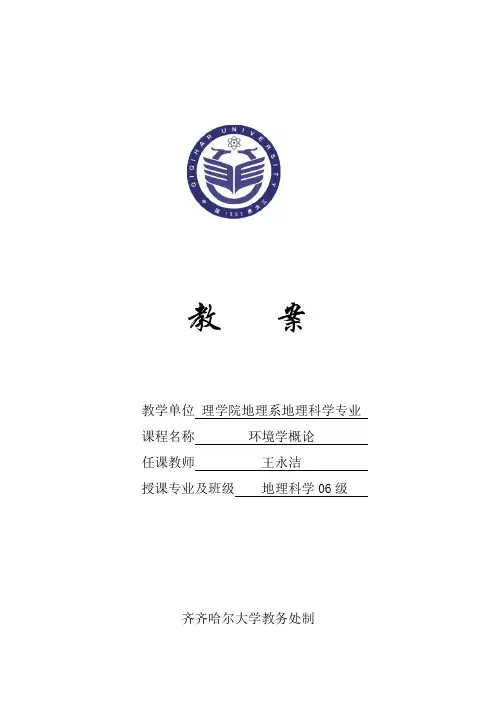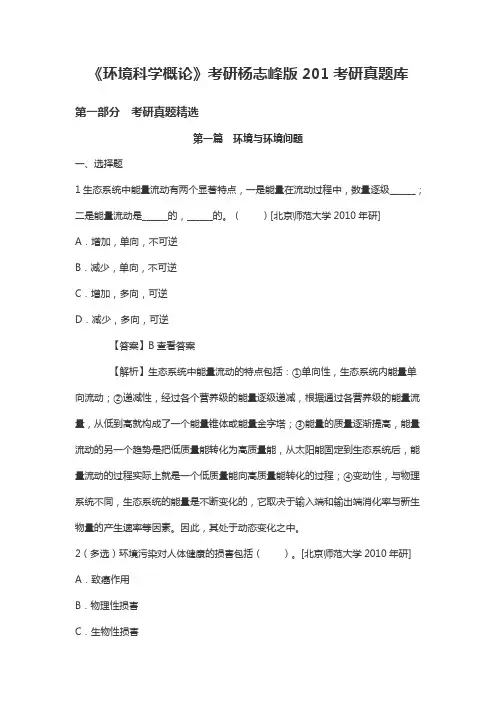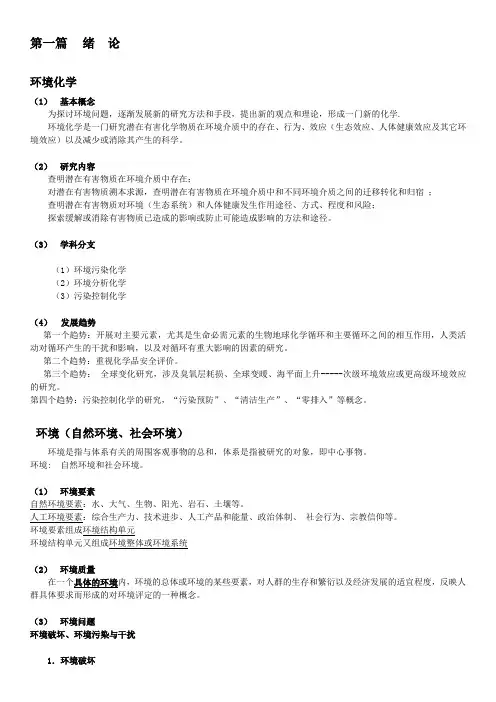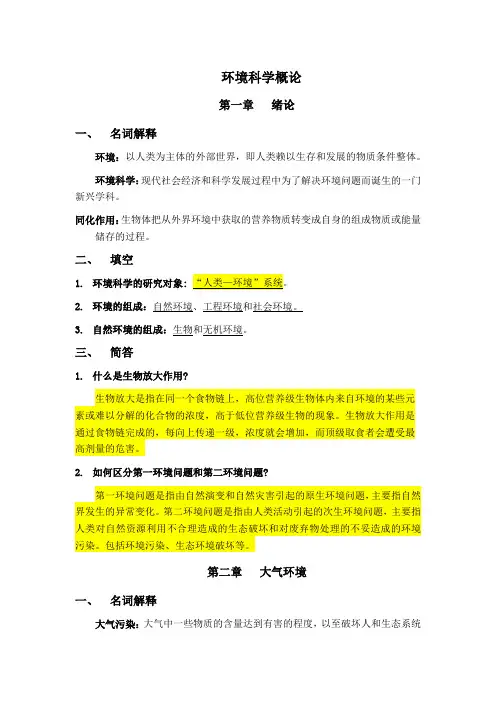中山大学环境科学概论Abstract
- 格式:docx
- 大小:135.97 KB
- 文档页数:8

教案教学单位理学院地理系地理科学专业课程名称环境学概论任课教师王永洁授课专业及班级地理科学06级齐齐哈尔大学教务处制要求1.每次课程均应填写“齐齐哈尔大学课程教案”。
2.讲稿分手写讲稿和电子版讲稿。
⑴手写讲稿须用印制的“齐齐哈尔大学教学笔记”书写完成;⑵电子版讲稿格式使用学校统一制作的模板。
模板格式请在教务处网站上点击“教学质量管理”,进入教学质量科网络办公系统,在此系统的下载区下载。
2006 ~ 2007 学年度第二学期课程表第一大节第二大节第三大节第四大节第五大节第六大节星期一星期二1教4211-9,13-16星期三星期四1教5211-9,13-16星期五星期六星期日系主任审查备课情况意见:(教学笔记撰写质量是否符合要求,是否完成了规定的备课数量,是否允许开课。
)系主任(签字):年月日(基本格式要求)授课计划(2006 —2007 学年度第二学期)课程名称:环境学概论授课班级:地理科学06级总学时:48 本学期学时:48 填写时间:2007 年3 月5日课程讲授总体设计本课程是地理科学(师范类)专业本科生必修课。
该课程的内容包括:环境的组成、结构、环境的发展,人类活动所引起的环境问题、环境污染的基本概念、防治和规律,环境评价、环境管理、环境经济等基础知识、基本理论和基本技能。
环境保护就是利用环境科学的理论和方法,协调人类和环境的关系,解决各种环境问题,保护、改善和创建环境。
本课程安排在第四学期,考试课,3学分。
教学时数为48学时,其中,实验10学时。
全部课程内容分11章。
其中:环境科学系统、大气环境、水体环境、土壤环境、环境质量评价是本课程的重点,占有的学时多。
本课程采用多媒体形式进行教学,将启发式和研究式教学方法相结合。
教学重点是地理组成要素的环境污染及治理;环境质量评价。
及时与学生沟通,每周进行一次答疑活动,组织课堂讨论,注重培养学生的分析问题与创造性思维能力。
在教学改革方面,应该将理论教学与实践教学相结合。

《环境科学概论》考研杨志峰版201考研真题库第一部分考研真题精选第一篇环境与环境问题一、选择题1生态系统中能量流动有两个显著特点,一是能量在流动过程中,数量逐级______;二是能量流动是______的,______的。
()[北京师范大学2010年研]A.增加,单向,不可逆B.减少,单向,不可逆C.增加,多向,可逆D.减少,多向,可逆【答案】B查看答案【解析】生态系统中能量流动的特点包括:①单向性,生态系统内能量单向流动;②递减性,经过各个营养级的能量逐级递减,根据通过各营养级的能量流量,从低到高就构成了一个能量锥体或能量金字塔;③能量的质量逐渐提高,能量流动的另一个趋势是把低质量能转化为高质量能,从太阳能固定到生态系统后,能量流动的过程实际上就是一个低质量能向高质量能转化的过程;④变动性,与物理系统不同,生态系统的能量是不断变化的,它取决于输入端和输出端消化率与新生物量的产生速率等因素。
因此,其处于动态变化之中。
2(多选)环境污染对人体健康的损害包括()。
[北京师范大学2010年研] A.致癌作用B.物理性损害C.生物性损害D.化学性损害【答案】ABCD查看答案【解析】环境污染物对人体健康的损害,可表现为:①特异性损害,是指环境污染物可引起人体急性或慢性中毒,以及产生致畸作用、致突变作用和致癌作用等;②非特异性损害,是指一些多发病的发病率增高,人体抵抗力和生活质量下降等。
影响人体健康的环境因素可分为三类:①化学性因素,如有毒气体、重金属、农药等;②物理性因素,如噪声和振动、放射性物质和射频辐射等;③生物性因素,如细菌、病毒、寄生虫等。
这三类因素均会对人体健康造成损害。
二、填空题1根据大气的物理性质差异和垂直运动状况,可将大气圈分为五层,分别是______、______、______、______和______。
[北京师范大学2010年研]【答案】对流层;平流层;中间层;热成层;逸散层查看答案【解析】根据大气在垂直方向上温度、化学成分、荷电、运动状况等的差异,大气圈由低到高依次被分为五层:①对流层,存在对流和水平运动、雨雪云雾等天气现象,大气污染多在此层;②平流层,氧和臭氧吸收太阳辐射,温度随高度增加而上升,大气多水平运动,飞机飞行在此层;③中间层,最冷,大气对流运动,出现夜光云,有流星;④热成层,又称电离层,火箭、激光、多数流星在此层;⑤逸散层,大气稀薄,地心引力小,运动速度快的质点可完全摆脱地球引力场逸散入宇宙空间。

第一篇绪论环境化学(1)基本概念为探讨环境问题,逐渐发展新的研究方法和手段,提出新的观点和理论,形成一门新的化学.环境化学是一门研究潜在有害化学物质在环境介质中的存在、行为、效应(生态效应、人体健康效应及其它环境效应)以及减少或消除其产生的科学。
(2)研究内容查明潜在有害物质在环境介质中存在;对潜在有害物质溯本求源,查明潜在有害物质在环境介质中和不同环境介质之间的迁移转化和归宿;查明潜在有害物质对环境(生态系统)和人体健康发生作用途径、方式、程度和风险;探索缓解或消除有害物质已造成的影响或防止可能造成影响的方法和途径。
(3)学科分支(1)环境污染化学(2)环境分析化学(3)污染控制化学(4)发展趋势第一个趋势:开展对主要元素,尤其是生命必需元素的生物地球化学循环和主要循环之间的相互作用,人类活动对循环产生的干扰和影响,以及对循环有重大影响的因素的研究。
第二个趋势:重视化学品安全评价。
第三个趋势:全球变化研究,涉及臭氧层耗损、全球变暖、海平面上升-----次级环境效应或更高级环境效应的研究。
第四个趋势:污染控制化学的研究,“污染预防”、“清洁生产”、“零排入”等概念。
环境(自然环境、社会环境)环境是指与体系有关的周围客观事物的总和,体系是指被研究的对象,即中心事物。
环境: 自然环境和社会环境。
(1)环境要素自然环境要素:水、大气、生物、阳光、岩石、土壤等。
人工环境要素:综合生产力、技术进步、人工产品和能量、政治体制、社会行为、宗教信仰等。
环境要素组成环境结构单元环境结构单元又组成环境整体或环境系统(2)环境质量在一个具体的环境内,环境的总体或环境的某些要素,对人群的生存和繁衍以及经济发展的适宜程度,反映人群具体要求而形成的对环境评定的一种概念。
(3)环境问题环境破坏、环境污染与干扰1.环境破坏又称生态破坏。
指人类的社会活动产生的有关环境效应,导致环境结构与功能的变化,对人类的生存与发展产生不利影响。
![(NEW)中山大学环境科学与工程学院环境工程导论[专业硕士]历年考研真题汇编](https://uimg.taocdn.com/bd6e0b4c5ef7ba0d4b733ba4.webp)

环境科学概论第一章绪论一、名词解释环境:以人类为主体的外部世界,即人类赖以生存和发展的物质条件整体。
环境科学:现代社会经济和科学发展过程中为了解决环境问题而诞生的一门新兴学科。
同化作用:生物体把从外界环境中获取的营养物质转变成自身的组成物质或能量储存的过程。
二、填空1.环境科学的研究对象:2.环境的组成:自然环境、工程环境和社会环境。
3.自然环境的组成:生物和无机环境。
三、简答1.什么是生物放大作用?生物放大是指在同一个食物链上,高位营养级生物体内来自环境的某些元素或难以分解的化合物的浓度,高于低位营养级生物的现象。
生物放大作用是通过食物链完成的,每向上传递一级,浓度就会增加,而顶级取食者会遭受最高剂量的危害。
2.如何区分第一环境问题和第二环境问题?第一环境问题是指由自然演变和自然灾害引起的原生环境问题,主要指自然界发生的异常变化。
第二环境问题是指由人类活动引起的次生环境问题,主要指人类对自然资源利用不合理造成的生态破坏和对废弃物处理的不妥造成的环境污染。
包括环境污染、生态环境破坏等。
第二章大气环境一、名词解释大气污染:大气中一些物质的含量达到有害的程度,以至破坏人和生态系统的正常生存和发展,对人体、生态和材料造成危害的现象。
大气污染源:向大气环境排放有害物质或对大气环境产生有害影响的场所,设备和装置。
按污染物质来源可分为天然污染源和人为污染源。
一次污染物:直接从污染源排放的污染物质。
二次污染物:由一次污染物在大气中互相作用经化学反应或光化学反应形成的与一次污染物的物理、化学性质完全不同的新的大气污染物,其毒性比一次污染物还强。
干绝热递减率:干空气块或未饱和的湿空气块在绝热条件下每升高单位高度(通常取用单位高度为100)所造成的温度下降数值。
二、填空1.根据大气的垂直运动状况,将大气圈分为哪五层:对流层、平流层、中间层、热成层、逸散层。
2.根据逆温生成的过程,可将逆温分为五类:辐射逆温、下沉逆温、平流逆温、锋面逆温、湍流逆温。




Populationo Globally, 1 in 4 people lives in extreme poverty 地球上四分之一人口生活在极端贫困的环境中•Cannot meet basic need for food, clothing, shelter, health 无法满足基本生活需求,如食物、衣着、居所、健康o Difficult to meet population needs without exploiting earth’s resources 如果不剥削地球的资源,人们的需要将无法满足Gap between Rich and Pooro Highly Developed Countries (HDC) 发达国家•Complex industrialized bases, low population growth, high per capita incomes 复杂的工业基础,人口增长率低,人均收入高•Ex: US, Canada, Japan 如美国、加拿大、日本o Less Developed Countries (LDC) 不发达国家•Low level of industrialization, very high fertility rate, high infant mortality rate, low per capita income 工业化程度低,极高的出生率,婴儿死亡率高,人均收入低•Ex: Bangladesh, Mali, Ethiopia 如孟加拉、马里、埃塞俄比亚Types of Natural ResourcesEcological Footprinto The average amount of land, water and ocean required to provide that person with all the resources they consume 满足个人对资源需求的土地、IPAT ModelMeasures 3 factors that affect environmental impact (I)) 对3个决定环境影响的因子的测算I = P A TI:Environmental Impact P:Number of people,A: Affluence per person T: Environmental effect of technologiesEnvironmental Sustainabilityo The ability to meet current human need for natural resources without compromising the needs of future generations 既满足现代人的需求以不损害后代人满足需求的能力o Requires understanding: 要求我们必须意识到•The effects of our actions on the earth 我们的行为对地球的影响•That earth’s resources are not infinite 地球资源不是无尽的Tragedy of the Commonso Garrett James Hardin (1915-2003)o Solving Environmental Problems is result of struggle between: 解决环境问题是斗争的结果,原因是•Short term welfare 短期福利•Long term environmental stability and societal welfare 长期环境可持续性和社会福利o Garrett used Common Pastureland in medieval Europe to illustrate the struggle他以中世纪欧洲的草原说明斗争Sustainable Developmento Economic development that meets the needs of the present generation without compromising future generations 经济发展既满足现代人的需求以不损害后代人满足需求的能力Environmental Problems, Their Causes, and ConsequencesPollutant—A substance or effect which adversely alters the environment by changing the growth rate of species, interferes with the food chain, is toxic, or interferes with health, comfort amenities or property values of peoplePollution—Found at high enough levels in the environment to cause harm to organisms.Point sourceNonpoint sourcePollutants can have three types of unwanted effects:Can disrupt / degrade life-support systems.Can damage health and property.Can create nuisances such as noise and unpleasant smells, tastes, and sights. Nature-Human Activity- Environment ConnectionsHuman Capital:Human Goods and servicesEconomic HeatAnd Depletion of nonrenewable resources Natural Capital:Cultural Degradation of renewable resourcesSystems Pollution and wasteThe major causes of environmental problems are:Population growthWasteful resource usePovertyPoor environmental accountingEcological ignoranceHeavy metal pollution汞mercury Hg镉Cadmium Cd铬chromium Cr铅Lead PbWhat is Water Pollution?any physical (temperature, oxygen), chemical (mercury), or biological (disease, sewage) change to water that adversely effects its use by living thingsWater pollution is the contamination of water bodies such as lakes, rivers, oceans, and groundwater.It occurs when pollutants are discharged directly or indirectly into water bodies without adequate treatment to remove harmful constituents.Causes of Pollution (Water)Factors that contribute to water pollution can be categorized into two different groupsPoint sourcesNon-point sourcesPoint sources are the easiest to identify and controlNon point sources are ambiguously defined and harder to controlPoint SourcesSome point sources of water pollution includeWaste products from factoriesWaste from sewage systemWaste from power plantsWaste from underground coalminesWaste from oil wellsThey are called point sources because they are direct sources of water pollution and can be reduced and monitoredExample of a point source1.Sewage pipes2.Leaky gas tanks3.Industrial sites4.Injection wellsNon-point SourcesThe term non-point source encompasses a large range of sources such as:when rain or snow moves through the ground and picks up pollutants as it moves towards a major body of waterthe runoff of fertilizers from farm animals and crop landair pollutants getting washed or deposited to earthstorm water drainage from lawns, parking lots, and streetsNon-point source:1.Agriculture (soil, fertilizer,pesticides)2.Urban runoff (from pavement)3.Construction sites4.Air PollutionTypes of Water Pollution1.Biologicali.Infectious Disease(Pathogens)ii.Oxygen-Demanding WasteDirect (microbes in water):Typhoid, cholera, dysentery, hepatitis…Indirect(Water breeding carriers):malaria, yellow fever,west nile virus…2.Chemicali.Nutrients (Fertilizers)ii.Toxic Inorganic Materialsiii.Persistent Organic Pollutants (POP’s)1.Heavy metalsmercury,lead, tin…2.Super Toxic ElementsArsenic, selenium…3.Acids, salts, chlorine4.Radioactive Isotopes3.Physicali.Sedimentii.Thermal Pollutioniii.Solid WasteCauses:▪industry▪dams▪removal of vegetationAir PollutionCauses of Air PollutionOne of the main causes of air pollution is the release of carbon dioxide into the atmosphere, this happens because of Deforestation and fossil fuel burningSulfur dioxide is another air polluter and is released into the atmosphere by the burning of sulfur containing compounds of fossil fuels. Sulfur oxides are very dangerous to humans at a high concentration. Sulfur in the atmosphere is responsible for acid rainChlorofluorocarbons (CFCs) also contribute to air pollution by reducing the amount of ozone the stratosphere. CFCs come from a variety of places such as:the burning of plastic foam itemsleaking refrigerator equipmentspray cansNatural air pollutants can include:Smoke from wild firesMethane released from live stockVolcanic eruptionsAcid Rain•When emissions of sulfur dioxide and nitric oxide from stationary sources are transported long distances by winds, they form secondary pollutants such as nitrogen dioxide, nitric acid vapor, and droplets containing solutions of sulfuric acid, sulfate, and nitrate salts•These chemicals descend to the earth's surface in wet form as rain or snow and in dry form as a gases fog, dew, or solid particles, it is known as acid rain or acid depositionSmog•With the introduction of petroleum to replace coal economies in countries, photochemical smog has become predominant in many cities, which are located in sunny, warm, and dry climates with many motor vehicles •Worst episodes of photochemical smog tends to occur in summer Consequences continued•Sulfur dioxide, nitrogen oxides, ozone and peroxyacl nitrates (PANs), cause direct damage to leaves of crop plants and trees when they enter leaf pores (stomates)•Chronic exposure of leaves and needles to air pollutants can also break down the waxy coating that helps prevent excessive water loss and damage from diseases, pests, drought and frost•"In the midwestern United States crop losses of wheat, corn, soybeans, and peanuts from damage by ozone and acid deposition amount to about $5 billion a year". (Miller 498)Land PollutionFour Main causes of land pollution–Construction–Agriculture–Domestic waste–Industrial WasteConstructionBuildings take up resources and land, the trees are chopped down and used to make buildingsTakes away from places for animals and other organisms to live Consequences of Land Pollution•Land pollution exterminates wild life•Acid rain kills trees and other plants•The vegetation that provides food and shelter is destroyed•Land pollution can seriously disrupt the balance of nature, and, in extreme cases, can cause human fatalities•Pesticides can damage crops; kill vegetation; and poison birds, animals, and fish. Most pesticides kill or damage life forms other than those intended. For example, pesticides used in an effort to control or destroy undesirable vegetation and insects often destroy birds and small animals. Some life forms develop immunity to pesticides used to destroy themRegulating Hazardous Waste⏹Hazardous waste:Any solid, liquid or containerized gas that can catch fire easily, is corrosive to skin tissues or metals, is unstable and can explode or release toxic fumes, or has harmful concentrations of one or more toxic materials that can leach out.⏹Toxic waste:Form of hazardous waste that causes death or serious injury (such as burns, respiratory diseases, cancers, or genetic mutations).Characters of Hazardous WastesTreatments for Hazardous Wastes⏹Solidification(e.g. cement process)⏹Chemical methods(e.g. neutralization of acids and bases, redox process, sedimentation, etc.)⏹Biological/bio-chemical methods(e.g. bioremediation, phytoremediation, etc.)Two Emerging Trends in Hazardous Waste T reatment⏹Bioremediation uses microorganisms (usually natural or geneticallyengineered bacteria) and enzymes to convert toxic or hazardous substances into harmless compounds.⏹Phytoremediation uses natural or genetically engineered plants to absorb,filter, and remove contaminants from polluted soil and water.。